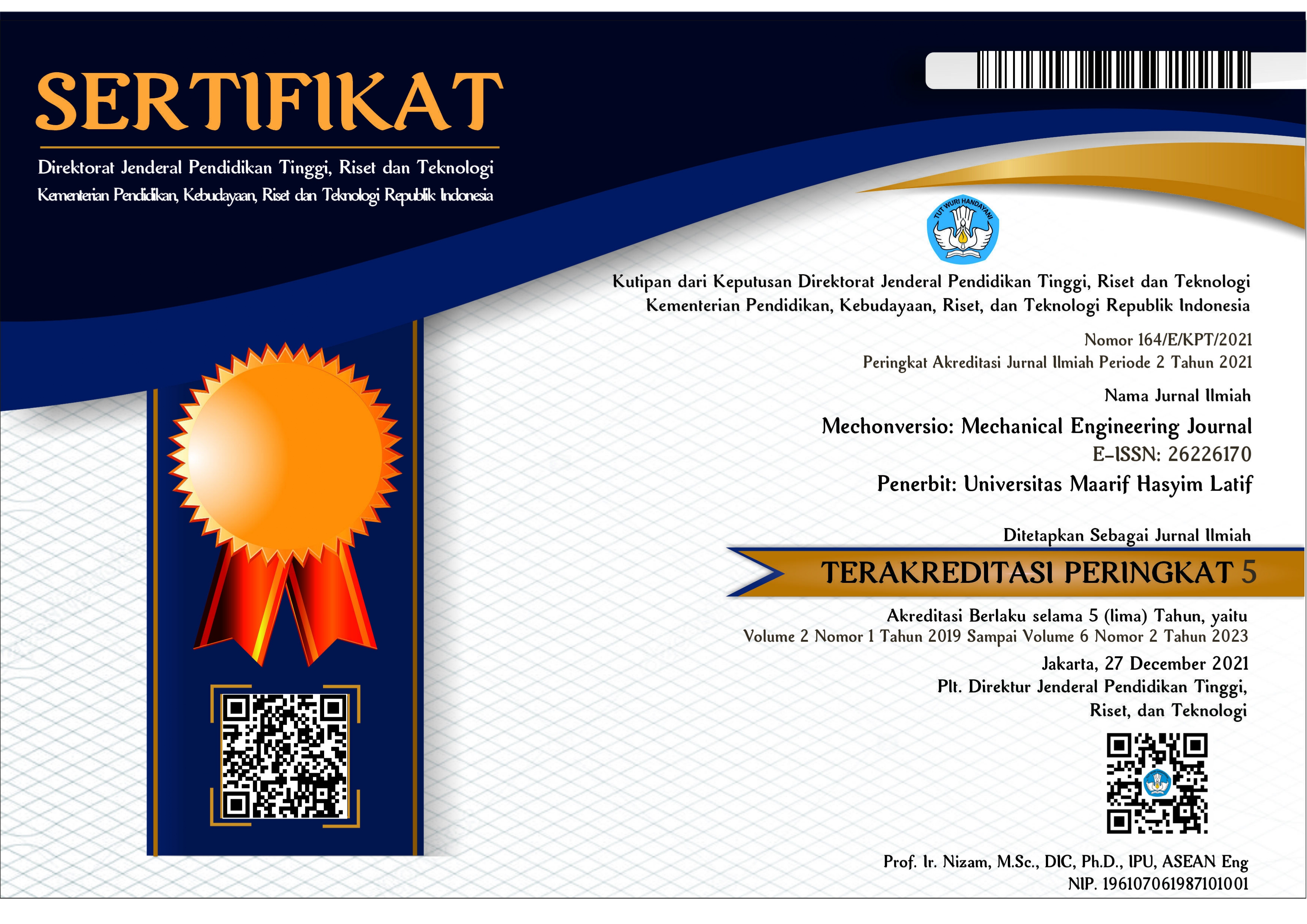PERANCANGAN DAN ANALISIS ROTOR PENGEREMAN HIDRAULIK DENGAN ANSYS UNTUK MOBIL LISTRIK KOMPETISI FSAE
DOI:
https://doi.org/10.51804/mmej.v7i2.16795Keywords:
disipasi panas, rotor, sistem pengereman hidraulik, ventilasi rotor, tegangan, deformasiAbstract
Penelitian ini berfokus pada desain dan analisis sistem pengereman hidraulik untuk mobil listrik Formula Student Automotive Engineering (FSAE) menggunakan perangkat lunak ANSYS. Tujuan utama adalah mengoptimalkan performa disipasi panas, distribusi tegangan, deformasi, dan bobot rotor. Simulasi dilakukan pada berbagai desain ventilasi rotor, termasuk ventilasi lurus, melengkung, serta kombinasi lubang dan slot. Hasil menunjukkan desain ventilasi melengkung menghasilkan disipasi panas yang lebih efisien dan suhu rotor lebih rendah dibandingkan desain lurus. Desain dengan kombinasi lubang dan slot mengurangi bobot tanpa mengorbankan kekuatan struktural. Distribusi tegangan yang merata pada desain optimal membantu mengurangi risiko deformasi dan kerusakan rotor. Kesimpulan dari penelitian ini menunjukkan bahwa desain rotor yang tepat dapat meningkatkan performa pengereman, mengurangi overheating, dan mempertahankan ketahanan material pada kondisi pengereman ekstrem. Hasil penelitian diharapkan dapat memberikan kontribusi pada pengembangan teknologi pengereman kendaraan listrik, khususnya untuk aplikasi kompetisi FSAE.
References
A. Lubi, "Perancangan Kampas Rem Beralur Dala Usaha Meningkatkan Kinerja Serta Umur Dari Kampas Rem," Jurnal Teknik Mesin, vol. 1, no. 22, 2001.
"Brake Parts - Brake Rotors," [Online]. Available: https://www.auto.howstuffworks.com/autoparts/brakes/brake-parts/brake-rotors1.htm.
M. Bouchetara, A. Belhocine, M. Nouby, D. C. Barton and A. Bakar, "Thermal Analysis ofVentilated and Full Disc Brake Rotors With Frictional Heat Generation," Applied Computer Mechanical, vol. 8, pp. 5-24, 2014.
Sanaka, D. S. Prasad and K. S. Kumar, "Analysis Comparison Performance Drilled Disc Rotor With Solid Disc Rotor". [8] D.-K. Chen, "The Effect of Cross Drilling and Slotting on Rotor Temperature," 2002.
P. N. Amrish, "Computer Aided Design and Analysis of Disc Brake Rotors," Advance Automotive Engineering, vol. 5, no. 2, 2016.
R. S. Kajabe and R. R. Navthar, "Optimization of Disc Brake Rotor With Modified Shape," vol. 3, no. 3, pp. 52-60, 2015.
wst, "Tribology The Study of Interacting Surfaces," WST, 09 05 2018. [Online].
Available: http://id.wstbearinguae.com/info/tribology-thestudy-of-interacting-surfaces-in-27306819.html.
Nurofik, 2017, “Pembuatan Dan Pengujian Rem Cakram Pada Prototype Mobil Listrik „Elang Untidar,?” 12(12), p. 12.
Alazhar, R. P., S, D. D., and Budiana, E. P., 2018, “Pengaruh Geometri Penampang Kampas Rem Cakram Terhadap Getaran Dan Indikasi Squeal Yang Muncul Saat Pengereman Pada Molina Uns,” J. Tek. Mesin Indones., 11(1), p. 13.
Dzikrullah, A. A., Qomaruddin, and Khabib, M., 2017, “Analisa Gesekan Pengereman Hidrolis (Rem Cakram) Dan Tromol Pada Kendaraam Roda Empat Dengan Menggunakan Metode Elemen Hingga,” Prosiiding Snatif, 4(February), pp. 667–678.
Lubis, S., 2019, “Analisis Pengaruh Besar Gesekan Terhadap Tegangan Thermal Pada Sepatu Rem Mobil Ketebalan 2 Mm Menggunakan Perangkat Lunak Msc. Nastran V.9,” 3(2), pp. 1–11.
Nurlia, S., 2019, “Analisa Simulasi Performansi Kampas Rem Komposit Dengan Variasi Beban Pemodelan Metode Elemen Hingga,” J. Din., 7(4), pp. 1–93.
Meifal Rusli, Mulyadi Bur, H. H., 2010, “Analisis Getaran Dan Suara Pada Rem Cakram Saat Beroprasi,” 9, pp. 1–8.
Siahaan, I. H., and Sen, H. yung, 2008, “Kinerja Rem Tromol Terhadap Kinerja Rem Cakram Kendaraan Roda Dua Pada Pengujain Stasioner,” pp. 1–7.
Bathe, Klaus Jurgen, 2014, Finite Element Procedures, New York: K.J. Bathe, Watertown, MA, USA.
Callister, William D, 1994, Materials Science And Engineering, John Willey &Sons,Inc. New York : McGraw-Hill, USA.
Downloads
Published
Issue
Section
License
Copyright (c) 2025 Mechonversio: Mechanical Engineering Journal

This work is licensed under a Creative Commons Attribution-ShareAlike 4.0 International License.
With the receipt of the article by MMEJ Editorial Board and the decision to be published, the copyright regarding the article will be transferred to MMEJ. The copyright transfer form can be downloaded here.
MMEJ has the right to multiply and distribute the article and every author is not allowed to publish the same article that was published in this journal.
MMEJ is licensed under a Creative Commons Attribution-ShareAlike 4.0 International License.
Under the following terms:
Attribution — You must give appropriate credit, provide a link to the license, and indicate if changes were made. You may do so in any reasonable manner, but not in any way that suggests the licensor endorses you or your use.
ShareAlike — If you remix, transform, or build upon the material, you must distribute your contributions under the same license as the original.




